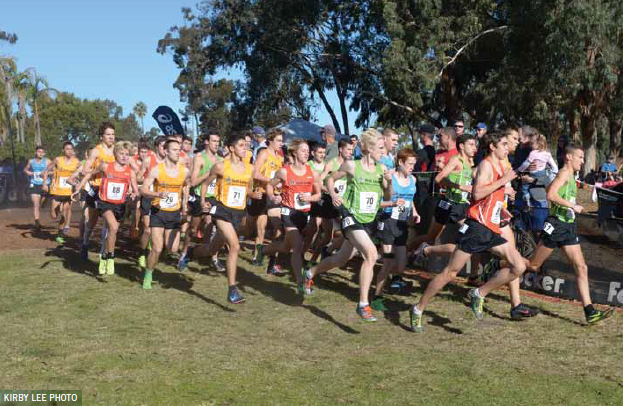|
The Dilemma - By: Larry Hannon Originally Published in Techniques Magazine - Provided by: USTFCCCA

Though eating disorders have the power to strike virtually anyone, certain people are especially at risk. Based on their environment and their personal predispositions distance runners are particularly vulnerable. A coach, an athlete or anyone else close to the sport of running should be familiar with the characteristics of eating disorders. This is true whether the athletes are female or male. First we will explore the nature of eating disorders and then investigate the collation to males and runners. The unique challenges of recognition, prevention and treatment will also be addressed. Eating disorders come in a variety of forms. Someone with anorexia severely limits food intake. A person with bulimia takes in large quantities of food and then takes extreme measures to expel it. These are the two most high-profile eating disorders but others exist as well. For example, being overly concerned with a muscular physique is known as Adonis complex and binge eating has the binging nature of bulimia without the purging. According to nationaleatingdisorders.org website there are also additional disordered types of eating which are not officially recognized. Orthorexia is a term coined by Steven Bratman, MD. Orthorexics obsess about healthy eating. Another unrecognized term, diabulimia refers to the condition in which an individual with an eating disorder, who also has diabetes, manipulates insulin levels to manage weight. As you can see eating disorders come from many points of attack. This makes diagnosing the problem and dealing with it even more difficult. With no intent to downplay the havoc that eating disorders inflict upon females, we will look more specifically at males and their unique set of struggles. These diseases can be dangerous and even fatal for both sexes. Males make up 10 percent of the eating disordered population. However, the likelihood is that the true figure could be higher. Males are less likely to report an eating disorder and less likely to be recognized as having one. The former issue comes because the person feels the stigma of the disorder and its association with the other sex.
Our culture, news, media and societal attitudes help to incite eating disorders, particularly the ones in which we strive to lose weight. This is true for men, women, boys and girls alike. We are all exposed to these powerful messages. Let's consider what we read, see and hear in regards to body mass and health. It does not look at things from a neutral reference point but rather as if our neutral point were overweight and fixed in a host of other abnormalities. For example, take note of how many research studies address weight loss, fat loss, curbing appetite and so forth. Then note how many address gaining weight and promoting a hearty appetite. The former far and away outnumbers the latter. From a dietary standpoint we tend to look at things from a biased perspective. For example, many people would believe there are such things as good fats and bad fats. Saturated fats are considered evil while unsaturated fats are not. The reality outlying this is that the body works best with a certain balance of fats and some saturated fats and cholesterol are actually necessary for bodily processes such as hormone production. This is just one example but there are many. Dietary or lifestyle changes good for someone who is overweight and in poor health are not necessarily the best for someone who is already eating well and in good health. They have a different point of reference. To think of it in running terms, more running would be good exercise for the average person. For someone who is already running 50 miles per week, maybe not. For someone who is already running 100 miles per week, it's rather doubtful. The nature of whether a change in anything is healthful is dependent upon the current state. Eating disorders can strike anyone and I certainly don't want to leave any small segment of the population out in the dark. However, for those of us who are runners or know runners we need to be particularly aware. Some of the same traits found in runners correlate very closely with those with eating disorders. Male runners share these traits with females and live just as much in a danger zone. With a sport such as running, there is essentially no ceiling on success. No matter how fast we run, we are always wondering how much faster we can go. A 4:30 miler will always strive for a 4:29 but once reached strive for a 4:28. The cycle will never end. In regards to body image this mentality can be dangerous. Someone who wants to become stronger or faster is in positive pursuit. On the other hand an unceasing pursuit of losing just one more pound can easily egress from positive and healthy to obsessive and destructive. To be a successful runner one usually needs to be highly motivated and driven. That pursuit of perfection that is infinitely unattainable can be a double edged sword. One of the running related catalysts for eating disorders actually lies in the attainment of success, observing results and improving. These things can be highly motivating to a runner or anyone for that matter. Some improvement sparks the desire for more. An idiosyncrasy of running that surely accompanies this is diminished returns. The product is someone who is motivated to improve yet finds it more and more difficult to do so. This is the perfect storm that can make that individual begin to search for answers and devise ways to continue the path of improvement. Those ways may or may not be healthy. Any runner can easily slip down this slope, though a very vulnerable model would be someone who was once overweight. Augmenting their sense of self enhancement is likely outside influences. In addition to watching seconds disappear on a watch and feeling healthier, words of encouragement and diminished criticisms provide an extrinsic energizer. Again, someone who finds some positive reinforcement seeks more. A larger component of the slipperiness of eating disorders lies in the gradual nature of how they attack. With some illnesses you may wake up one day feeling poorly and be acutely aware that something is wrong. Eating disorders almost never settle so abruptly upon their victims. They progress slowly, often manifesting from what was originally a healthy, enriching set of goals. In relation to a running concept consider the athlete who takes a misstep on a cross country course and twists a knee. He or she knows distinctly where and what went wrong. On the other hand consider the runner who has deteriorated from a 17:00 5K time to a 17:08 over a period of two months. This case is less likely to provide an easy answer to where and how a blunder was made. It is more difficult to detect a problem is even developing. Significantly, it is important to keep in mind that this runner has a good possibility of not even addressing the problem correctly. For example, an overtraining situation may not be recognized and the runner may begin adding miles, doing the exact opposite of what is needed to make true corrections. Eating disorders are more like the latter situation. They creep in slowly and often provide no distinct point of commencement or recognition. Similar to an overtraining situation, the individual being afflicted is likely to misaddress the issue once it does become apparent. To compensate for feeling poorly someone with disordered eating may try to limit food intake even more. By the time an eating disorder is recognized it has often rooted itself deeply into the psyche of the individual it is inflicting itself upon. A deep psychological entrenchment is one of the key reasons that an eating disorder is so difficult to combat. As someone who has personally dealt with an eating disorder I understand just how firm of a grasp it can take and just how powerful it can become. I also truly believe someone cannot truly understand what it is like to have an eating disorder until they have actually experienced it. It would be like attempting to explain what it is like to run a middle distance race to someone else. No matter what you convey to them or how vivid your imagery may be there is something they will never quite understand until they are 700 meters into an 800 meter race. An eating disorder is the same way. Until it has fully gripped you and infiltrated into your being, you cannot fully grasp what it is like. The desire to be thin is a simple concept but it does not come close to truly conveying the psychological state of someone with an eating disorder. An eating disorder holds the power to easily transcend all other things in life. Every waking moment and many sleeping ones are prone to being engrossed by obsessive thoughts of food, body weight and calculations of every calorie. Planning how to deal with these issues becomes a focal point in life. For example, something as simple as a holiday meal or picnic can trigger weeks of anguish and detailed internal planning. If the person with the eating disorder can manage to eat, there is compensation. A bulimic will of course purge the actual food. Others may become obsessive about exercising for long durations. Regardless, someone with an eating disorder needs to feel some route of escape from their worst fear, food.
As I mentioned earlier, eating disorders share with running the trait of infinitely escaping satisfaction. Perfection cannot be attained because these things slide on scales with essentially no ceilings. Someone with an eating disorder will never reach a weight and feel satisfied. No matter how far skewed from healthy they are they will always strive to go further. In this sense, the mere existence of someone with an eating disorder is a problem in their mind. Satisfaction will not be reached until they have eradicated their entire physical being. They may be not much more than bone, skin and some bodily organs. However in their mind, this is too much. If left to perpetually advance with no changes in course an eating disorder has no practical end. Unless tamed, an eating disorder will unceasingly lead its victim toward literal self destruction. Diseases and illnesses carry with them unique characteristics and idiosyncrasies in the nature of their treatment. Some can be completely eradicated and done so in an on/off, white/black way. For example someone who has overcome alcoholism neatly and wholly avoids alcohol. Someone beating an eating disorder faces a very different situation. Human beings must consume food, should do so discriminately, should exercise and are required to live within a physical body. There are no ways to completely avoid some of the very things that comprise the core of an eating disorder. The fact that food consumption is an essential part of life makes overcoming and preventing the re-occurrence of an eating disorder very challenging. Unlike some diseases and disorders, someone recovering from an eating disorder is forced to continually play with fire. The disorder resides in the fire, always ready to strike its victim. Overcoming an eating disorder is a great fortune but it is not the end of a race. The individual will always carry a certain level of vulnerability and the outside pressures will never completely perish. Vigilance will always be necessary in order to prevent a relapse. First of all, one must be aware of the triggers for an eating disorder. There are vast societal triggers but many are also individual in nature. It is important to learn the details of someone's personality and what things may set them on the wrong course. Life events and structures such as losing a job, relationship failures, running performance or lack thereof, social company and approval or disapproval from others are just some of the many things that can set a mind rolling. Before an eating disorder has fully taken hold a door of retraction still may exist. This is particularly true in someone who has already been through it and thus has an understanding of what is taking place. When eating or the thought of it begins to grasp for more and more attention and inflict more and more stress, a dangerous path has been embarked upon. Sometimes the things that create the most anxiety for the person are the very things that can be used to combat the disorder. For example, a fear of eating dessert may be tamed by eating one. The act of eating the dessert combined with the realization that nothing horrible resulted from it can curb some of that anxiety. Attacking a fear head-on is likely the foremost method of combating it. Of course the further an eating disorder is permitted to progress the more difficult that fear conquering becomes. There are various methods in curbing an oncoming eating disorder and the most appropriate depends on the nature of the individual and the environment in which he or she is in. At times a change to the environment can be powerful. Just as scary movies can provoke nightmares, violent games can influence children and partisan news can sway opinions, environmental factors hold the power to influence the onset of an eating disorder or the prevention. This can be very difficult to control or even identify. For example, someone may see pictures of slender or athletic figures in a magazine and be influenced, perhaps even subconsciously. This type of case is particularly dangerous. It is possible that nobody, not even the potential victim, is aware of the psychological sway taking place. The tricky web nature of eating dis-orders can entangle a male with just as much force as a female. The tendency to overlook or dismiss cases of eating disorders in males places them in a perilous situation. Anybody who overcomes an eating disorder ultimately makes their own decisions and fate rests with them. However, encouragement, guidance and counsel from others can play an important role in influencing these decisions. Society is more likely to recognize and accept a female with an eating disorder. Even parents, family and others with close relationships may be slower to connect with the status in a male over a female. This is likely not due to a deliberate discrimination but instead to their own perceptions which have been influenced by society. A coach may very well be the last line of defense in combating an eating disorder in a male. Fortunately, a coach has a grasp on the correlations between a running mentality and a disordered eating one. Also, a coach often has a close view of the exercise habits of an athlete. Depending on circumstances perhaps the coach can stay abreast of eating habits as well. A coach may be one of the most respected people in an athlete's life. Significantly, a coach is in a position to control the environment, promote values and attitudes and encourage or discourage the thoughts and actions of an athlete. The support of teammates can certainly be beneficial to an athlete with an eating disorder. Depending on relationships and position in the team structure some athletes may hold significant power to influence others. Of course, this poses a potential danger as well. An athlete that demonstrates disordered eating can encourage others to follow such a path. This is particularly true if that athlete is highly respected and, or successful. The goal however is that the benefit outweighs the cost. Athletes can encourage their teammates to eat a healthy diet, promoting recovery and providing the fuel for the challenges of practices and competition. Perhaps nothing would help more than the demonstration of such attitudes and behaviors. Identifying eating disorders in runners holds special challenges. Generally, they are thinner and leaner than the general public, especially in the American society. From the physical stature standpoint they may not be as much of an anomaly and it is easier for them to blend in with their peers. Except in severe cases identifying an eating disorder may take more than a quick look. It may take some observation of eating habits and even an understanding of thought patterns to truly grasp what is taking place. Lack of food intake is an obvious indicator but the signs are much more numerous than that. High or fluctuating food intake can also be a sign that something is amiss. Frequent trips to the bathroom, odd sizes of clothing, unexplained anxiety around eating times and incessant self weighing are some of the signs of an eating disorder. Beyond significant changes in weight there are a variety of physical consequences of an eating disorder. Anorexia can cause the following: • Abnormally slow heart rate and low blood pressure, which mean that the heart muscle is changing. The risk for heart failure rises as the heart rate and blood pressure levels sink lower and lower. • Reduction of bone density (osteoporosis), which results in dry, brittle bones. • Muscle loss and weakness. • Severe dehydration, which can result in kidney failure. • Fainting, fatigue, and overall weakness. • Dry hair and skin; hair loss is common. • Growth of a downy layer of hair called lanugo all over the body, including the face, in an effort to keep the body warm. Bulimia can cause the following: • Electrolyte imbalances that can lead to irregular heartbeats and possibly heart failure and death. Electrolyte imbalance is caused by dehydration and loss of potassium, sodium and chloride from the body as a result of purging behaviors. • Potential for gastric rupture during periods of binge eating. • Inflammation and possible rupture of the esophagus from frequent vomiting. • Tooth decay and staining from stomach acids released during frequent vomiting. • Chronic irregular bowel movements and constipation as a result of laxative abuse. • Peptic ulcers and pancreatitis. Treatment for an eating disorder is more individualistic than it is sometimes made out to be. Professional help has a place but those with direct relationships may hold a special key in the process. The reasons for acquiring an eating disorder are varied from person to person just as the nature of their disorder and deciphering this can be a large piece of the puzzle. A coach, teammates, friends and family can influence how and if a person runs or competes but the ultimate responsibility lies with the athlete. When the moment of truth comes, nobody can run the race for you. The battle against an eating disorder is the same. Help and encouragement can come in many forms from many directions. As important as these influences are, the ultimate decision can only be made in one place. That is the heart of the competitor. To help someone with an eating disorder it is important to build trust and confidence in that individual. It is important to understand what is motivating them or discouraging them. It is important to promote positive attitudes and healthy behaviors. It is important to discourage negative behaviors without impressing guilt or shame. It is important to teach them and let them know they are valued. It is important to provide the resources and opportunities to succeed. A coach should be familiar with all of these and the last stands above all. It is crucial that the person struggling with an eating disorder feels empowered and knows success ultimately comes through their own hard work and determination. Sources: Larry Hannon is a former cross country and track & field coach at the NCAA Division III level and author.
|









